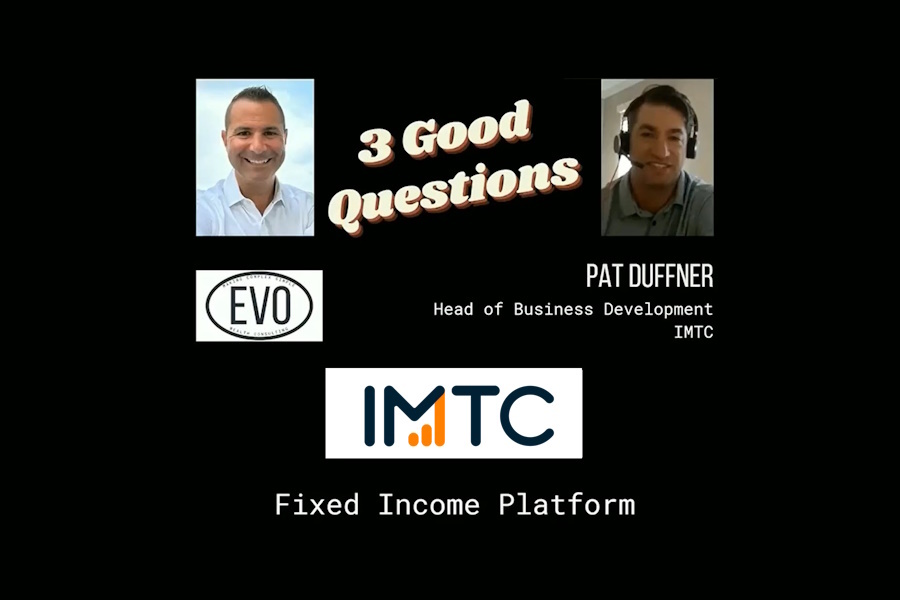Munis and Tech: Capitalizing on Opportunities in 2021

The fixed income world has been affected by the COVID-19 pandemic and the muni market is no exception. Working from home has accelerated the use of technology, while government intervention has affected interest rates and the outlook for issuance. Clearly, 2021 will be an interesting time for muni managers, who will need to be nimble, cost-conscious, and efficient to add value for clients.
In our continued webinar series focused on performance, our panelists focused on how the pandemic affected the use of technology in the muni market, the outlook for a COVID-19 recovery, and the impact on new issuance. Panelists also discussed the growing emphasis on ESG and the market for green bonds. We invite you to watch the on-demand recording of Munis and Tech: Capitalizing on Opportunities in 2021, moderated by Chris Ferreri, COO of the brokerage firm Hartfield, Titus and Donnelly.
Working from home accelerated the use of technology (beyond Zoom)
A big story during the pandemic has been the speed with which businesses and consumers adopted, and adapted to, new technologies from their living rooms. Technology has clearly helped bring efficiencies to asset and wealth management firms over the past year (despite zoom fatigue). Muni managers also saw several common challenges and solutions.
Exploring riskier strategies
Patricia Healy, SVP of Research at Cumberland Advisors, highlighted the need for more data and technology as they explored new strategies including riskier issuers that had been most affected by the pandemic. This pandemic-affected municipal bond strategy meant they were investing in securities that they hadn’t previously, comprised mostly of BBBs in areas they thought would be part of the V-shaped recovery. As the firm moved down in credit quality to find yield in riskier assets, they need to double-down on due diligence to ensure they’re investing in the right securities. Without the efficiency of their technology, this would not have been possible.
Automating manual investment processes
According to Craig Maschmeyer of Goelzer Investment Management, his firm has relied heavily on technology platforms, including Bloomberg, IMTC, Tradeweb, and others to successfully automate many of their manual processes during the pandemic. Craig noted, “IMTC’s Targets feature has been tremendously useful in streamlining allocations. The ability to adjust durations or credit exposure optimally, across large numbers of portfolios while adhering to compliance standards is extremely useful.”
Technology aids in liquidity challenges
Electronic trading of munis continued to increase during the pandemic. Moderator Chris Ferreri asked whether technology has also encouraged the use of portfolio trading in the muni arena, as it has become popular in the corporate bond space. “We see portfolio trading as the next step in our goals for automating trades,” Craig Maschmeyer commented. “Low rates make it even less profitable for dealers to hold inventory to make a tiny profit on one trade.” Portfolio trades in munis could improve that situation for both the sell-side and buy-side and could help to address the chronic problem of illiquidity in the muni arena.
Not a replacement for human relationships
As the use of technology increased during the pandemic, were relationships between the buy-side and broker-dealers affected, or even replaced? The sense is that while technology makes things more efficient and drives down costs, human interactions are also important and cannot be replaced by technology. For example, every state has its own laws governing issuance, and broker-dealers in each state help traders and portfolio managers to identify state-specific pockets of opportunities. Technology cannot replace that knowledge.
Uncertainty emerges as a central theme for muni investors
A theme that was present throughout most of the conversation was uncertainty and its impact on markets. When the pandemic began, there was great concern about how people would work from home, but many firms found business continued without skipping a beat. Uncertainty about the economy and the timing of a recovery, along with government stimulus spending remained a steadfast challenge. Additionally, fixed income managers continue to deal with potential inflation concerns as the Fed keeps interest rates at new lows. Fears of shrinking tax revenues and decimated state budgets haven’t emerged to the degree anticipated. However, there is great uncertainty about what the recovery will look like, what the new normal looks like, and how that will affect muni bond issuance.
The impact of low interest rates
Most of 2020 was characterized by persistently low interest rates, a mostly flat yield curve, and a flat credit curve. According to Patty Healy, “As the market tanked last March and rates fell, clients needed a lot of hand-holding. Now, clients are worried about inflation, but we think the recent run-up in rates is more of a return to a more normal environment.” There is uncertainty about how quickly long rates will move, whether the Fed will stick to its commitment to keep short-term rates low, whether a slower recovery in Europe will make the U.S. bond market more appealing, and how all of this will impact the muni market.
Recovery uncertainty leaves muni investors uncertain
There is also uncertainty about the timing of and opportunities in a pandemic recovery. For muni investors, airport, convention center, and higher education bonds may be attractive, such as Cumberland’s pandemic-affected municipal bond strategy, but caution is warranted. Returning to full capacity is likely to take two to three years for airports, although toll road receipts, as well as property and sales tax revenues, are likely to recover sooner. In Patty’s view, with vaccines becoming more available, “people are going to want to go out and spend,” which will boost tax revenues.
Maschmeyer noted that the CARES Act placed the burden of pandemic-related government spending mostly on the Federal government. Tax revenues are in a great position to bounce back, especially since income taxes have not fallen off a cliff as was expected in the early days of the pandemic, keeping most state’s budgets out of crisis mode. However, the question still remains of what the impact will be to cities as more companies adopt fully remote or hybrid working patterns.
An overwhelming need for infrastructure spending
For municipal issuers, the pandemic wreaked havoc on previously reliable sources of revenue that supported infrastructure spending. With people working from home, bus fare revenues, toll road receipts, gasoline taxes, parking lot fees, etc., declined precipitously. Not only have revenues decline, but the need to upgrade is precipitous. Panelist John Markowitz, Assistant Treasurer at Transurban points out, “The U.S. continues to rate a D+ or C- in terms of infrastructure. Our needs are tremendous and public/private partnerships – which were helpful in developing vaccines in record time – could be an important way of funding infrastructure improvements.”
The panelists noted that there is a significant demand for infrastructure bond issues. Pre-COVID, there was money on the sidelines waiting to be invested in infrastructure and that money is still there, although some expectations have changed. Interest in infrastructure bonds on the part of international investors is also strong on the taxable muni side.
ESG and the rise of sustainability initiatives
No one can doubt the prevalence of ESG in the investment world, though the conversations are slightly different in fixed income, and specifically, munis. For some, ESG elements have always been a component of credit analysis. However, the idea of green bond funds and ESG ratings don’t seem to take off at the same pace as on the equity side.
Where are we seeing green in munis?
In some respects, the muni market is already sustainability-oriented – the projects that state funding supports are community-oriented, by nature. From an issuer’s point of view, panelist John Markowitz felt this was important to emphasize. Improving bridges and roads is expected to incorporate ESG principles as the world begins to shift from internal-combustion engines to electric vehicles. Municipalities will continue to switch to electric vehicles for public transportation, although there are questions about grid reliability and the availability of charging stations.
ESG impact and correlation to ratings
There is a sense of optimism among issuers that green bonds will receive better ratings and pricing advantages going forward, as this becomes more and more important to investors. Credit rating agencies are well aware that environmental issues such as rising sea levels are threatening the tax base in certain localities.
As for new strategies arising from anticipated infrastructure spending and green bonds, the market is not yet seeing a big difference in pricing for green bonds but that may be due to an insufficient track record. Patty Healy pointed out that rating agencies are now looking at ESG from a risk perspective but noted that this is not the same as giving a “stamp of approval” regarding whether an issue is a green bond. Definitions of impact are highly individualized; some may emphasize a project’s environmental aspects, while others may focus on whether work is done by unionized labor. There is also a concern about greenwashing.
Mini-survey: Are our panelists ready to travel?
Attending conferences has traditionally been an important part of the muni market ecosystem. Will our panelists be attending muni industry conferences later this year or early next year? The responses were unanimous: Yes! That’s how we learn and communicate. It is part of human nature, part of how we train employees. Zoom has been tremendously useful to get us through this, but the panelists are eager to return to traveling, attending conferences, and seeing people in person.
Technology is only as good as how it is used. IMTC is designed by and for fixed income professionals, empowering them to take action and make decisions quickly and accurately with real-time data and analytics capabilities. It allows you to future-proof your business; driving operational efficiencies, mitigating risk and delivering performance, to ultimately enable business growth.
This paper is intended for information and discussion purposes only. The information contained in this publication is derived from data obtained from sources believed by IMTC to be reliable and is given in good faith, but no guarantees are made by IMTC with regard to the accuracy, completeness, or suitability of the information presented. Nothing within this paper should be relied upon as investment advice, and nothing within shall confer rights or remedies upon, you or any of your employees, creditors, holders of securities or other equity holders or any other person. Any opinions expressed reflect the current judgment of the authors of this paper and do not necessarily represent the opinion of IMTC. IMTC expressly disclaims all representations and warranties, express, implied, statutory or otherwise, whatsoever, including, but not limited to: (i) warranties of merchantability, fitness for a particular purpose, suitability, usage, title, or noninfringement; (ii) that the contents of this white paper are free from error; and (iii) that such contents will not infringe third-party rights. The information contained within this paper is the intellectual property of IMTC and any further dissemination of this paper should attribute rights to IMTC and include this disclaimer.





